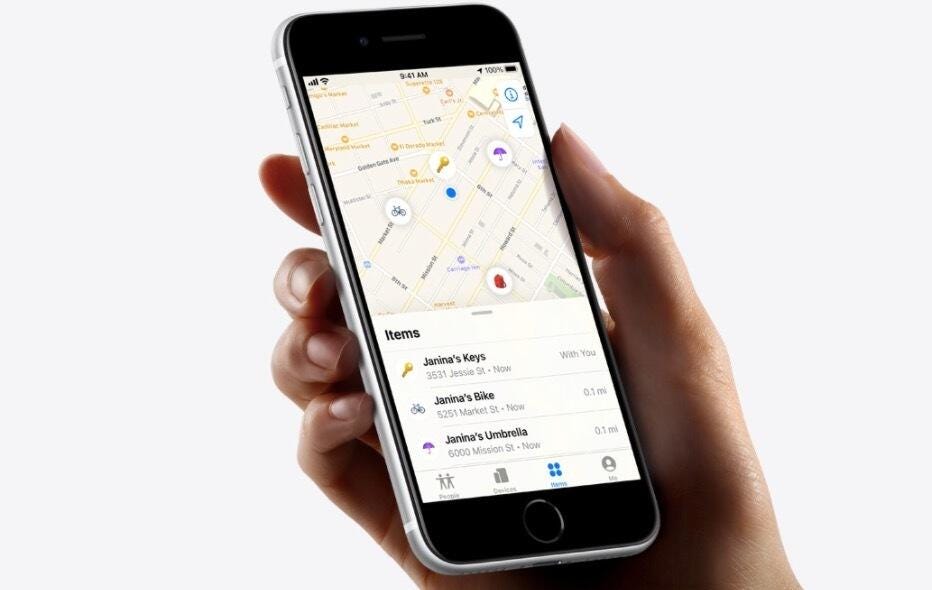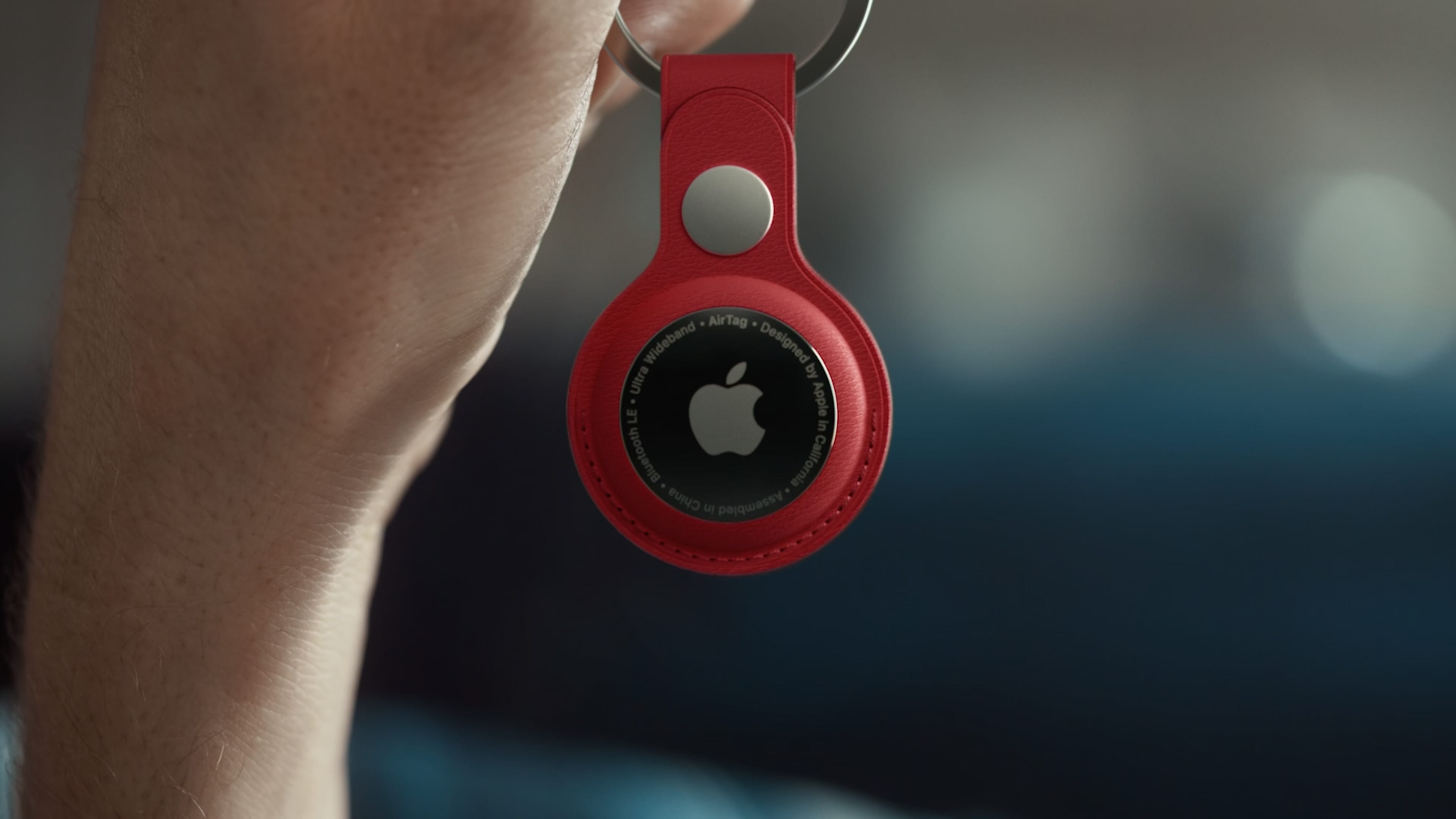
The AirTag and the Find My app are designed to make keeping track of your items easy.
AppleApple unveiled its AirTag tracking tiles Tuesday at Spring Loaded -- the company's first virtual event of 2021. The reveal comes the same month Apple began allowing its Find My app to locate lost items made by third-party companies, signaling the iPhone maker's growing interest in tracking tech outside of core Apple offerings.
Rumors of an upcoming AirTag product had gone back to 2019, and the pieces began to fall into place for Apple watchers after AirTag tech was hinted at in the iOS 13 code and when the iPhone 11 was found to have incorporated ultra wideband, or UWB, technology. The groundwork for the gadget was laid even farther back, in 2014, with the iBeacon, a small, inexpensive Bluetooth transmitter that aimed to provide location-based information and services to iPhones. While Bluetooth can track items to within about five meters, UWB can track them to within five to 10 centimeters.
Now that Apple's tracking tag has arrived, here's everything you need to know about the AirTag and how it works.
What's an AirTag?
The AirTag works similarly to the Tile tag in that you can clip one of the small devices onto keys, a bag or whatever using a separate key chain. The tag can be used without the key chain as well and slipped into a wallet or bag. The AirTag can be paired with items like your iPhone, and it works with the Find My app.
The AirTag is a small, lightweight, stainless steel disc with the Apple logo on one side. You can personalize the other side with a free engraving. The new device is also water and dust resistant, with a removable cover designed to make it easy to change the CR2032 battery, which promises a year's worth of battery life with everyday use.

With one of the AirTag key chains, you can easily attach your tag to bags, keys and more.
AppleHow much do AirTags cost and when can I get one?
If you want to order an AirTag, you'll be able to do so on April 23 (here's where you can preorder an AirTag). General sale of the tags begins on April 30. The new tech costs $29 per tag, or $99 for a four pack. And though it's not required, you can more easily attach AirTags to your items with the key chain accessory. Here's what Apple is offering:
- AirTag leather key ring for $35 in Baltic blue, saddle brown, Product Red.
- AirTag leather loop for $39 in saddle brown and Product Red.
- AirTag polyurethane loop for $29 in electric orange, sunflower, deep navy and white.
- Belkin Secure Holder with strap for $13 in white, black, blue and pink.
- Belkin Secure Holder with key ring for $13 in white, black, blue and pink.
In addition, Apple and Hermès created AirTag Hermès, which features a line of handcrafted leather bag charms, key rings and travel and luggage tags:
- AirTag Hermès key ring starting at $349 in orange, bleu indigo and fauve.
- AirTag Hermès bag charm starting at $299 in orange, bleu indigo and fauve.
- AirTag Hermès luggage charm starting at $449 in fauve.

Key chain holding an AirTag, to clip on to your items.
Screenshot by CNETHow does the AirTag work?
After you set up the AirTag, a process Apple says works the same as paring AirPods, it'll appear in the new items tab of the Find My app. You can name your items as well, with suggestions from the app or names of your own.
From there, you can see the item's last known location if you've attached an AirTag to it. If the item is within Bluetooth range, you can use the Find My app to signal the AirTag's built-in speaker to play a sound. AirTags also have Siri-support, so your iOS assistant can help you locate the lost item.

With the Find My app, you can pair your AirTags and name all the items you've connected.
AppleThe tags and the Find My app take advantage of Apple's U1 chip with Ultra Wideband technology to use Precision Finding, a feature that relies on camera input, ARKit, accelerometer and gyroscope to guide you to your AirTag using sound and haptic and visual feedback. With the Find My app, you'll get helpful notes like how many feet away your AirTag is and in what direction. Precision Finding also has a voice-over option to help low-vision or blind users.
If you're out of Bluetooth range, you can put your AirTag into Lost mode and get a notification when it's within range of the Find My network. If someone else finds your AirTag, she or he can use an iPhone or NFC-capable device to view your contact number, if you've listed it.
Do AirTags keep my information private?
During its AirTag announcement on Tuesday, Apple touched on privacy. The company said people can participate in the Find My network without having the share their location with anyone, including Apple. Carolyn Wolfman-Estrada, an engineer at Apple, said safety features are in place that discourage unwanted tracking.
"AirTag is designed to track items, not people," Wolfman-Estrada said during Tuesday's event.
AirTags don't store any location data or history, and communication history through the Find My app is end-to-end encrypted, according to Apple.
What can I get engraved on my AirTag?
Apple will engrave one side of your AirTag for free after you purchase. When you reach the order screen, you can use the letters of the alphabet, numbers (zero through 50), and any of 31 different emojis. Because the tag is small, you can choose up to four characters to engrave on the back. As you choose your emojis, letters and numbers, you'll see a preview of what the tag will look like engraved.

A look at the emoji engravings you can get on your AirTag.
AppleWhat do I need to use AirTags?
AirTags will need a device running iOS 14.5 or later. Users will also need an Apple ID to sign in to their iCloud account. Here are the compatible devices:
- iPhone SE, 6s or later.
- iPod Touch 7th generation or later.
- iPad Pro, 5th generation or later.
- iPad Air 2 or later.
- iPad Mini 4.
https://ift.tt/3n7am1q
Technology
Bagikan Berita Ini















0 Response to "Apple AirTags: Price, preorder date, bundle cost, engraving and everything else to know - CNET"
Post a Comment